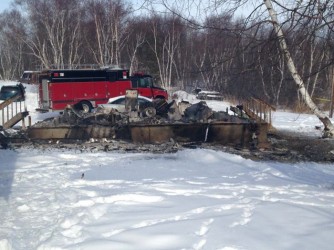Article Origin
Volume
Issue
Year
An unanswered call for help on the Makwa Sahgaiehcan First Nation for an early morning house fire has left two children dead, two communities reeling, and a renewed call for better funding from the federal government for emergency response services.
On Feb. 17, a call was placed to the neighboring Loon Lake volunteer fire department, but the only emergency responders were the RCMP who arrived at 1:30 a.m. to find the residence engulfed in flames. Pronounced dead at the scene were two-year-old Harley Cheenanow and his 18-month-old sister Haley. The grandmother was treated in hospital and released.
“There are more questions than answers right now at least from where I sit,” said Federation of Saskatchewan Indian Nation Vice-Chief Dutch Lerat.
“It’s very tragic that two people lost their lives in that fire. Both sides of the community are very rocked at the moment,” said Laurie LeHoux, administrator with the Village of Loon Lake. “The reserve is in very close proximity to the town so a lot of people know each other. It’s been very hard on both communities.”
Emotions are running so high that a posting on social media the same day of the fire resulted in an arrest. Tony Mitsuing, 27, was charged with Utter Threats and released on conditions to not contact the adult male from Loon Lake that he threatened in his posting. According to the RCMP, Mitsuing’s threat “pertained to the non-attendance of the Loon Lake Fire Department at the fatal house fire on the Makwa Sahgaiehcan First Nation.”
The 911 to respond to the fire on the reserve is the first fire call received since the village stopped delivering firefighting services in the late fall of 2014, said LeHoux. Services were ended in response to an agreement signed in 2013 that declared if fire bills were not paid within 30 days after the billing was received “the fire agreement will be considered void and all fire services will be revoked.”
The band’s bill, which was payment owing from March to May 2014, was in arrears. The band did not make LeHoux aware as to why the bill was not being paid. LeHoux said she sent regular inquiries to the First Nation but received no response. The last correspondence sent to the band, both by email and post was dated Jan. 30, 2015, and stated, “The band is now well over three months behind on payment for their fire bills. The Loon Lake Fire Department will not be responding to any fires on the First Nations until this account is paid in full.” LeHoux said the band has stated it did not receive the last letter.
“It’s a worst case scenario in terms of the local fire department that got the call and didn’t respond and children died. That’s tragic and we have to find a solution as to why that happened and to ensure that doesn’t happen again and to look for answers,” said Lerat.
Aboriginal Affairs and Northern Development Canada funds $26 million annually for First Nations fire protection services on reserve. In the 2014-2015 fiscal year, the Makwa Sahgaiehcan First Nation received $33,999 of federal funding for operation and maintenance of fire protection services, said department spokesperson Emily Hillstrom in an email interview.
She would not confirm whether Makwa Sahgaiehcan had received $11,000 in each of the two previous years nor did she respond to a question as to whether or not First Nations considered the funding they received for fire protection services to be adequate.
Lerat is adamant that the funding is “absolutely not” enough considering it is $26 million to be shared among over 600 First Nations.
Deaths from fires on First Nations reserves are 10 times higher than in similar off-reserve communities, according to a 2010 strategy on fire protection by AANDC.
Lerat said concerns over funding have been raised with the minister.
“We haven’t been getting a very positive response because in my estimation the federal government has created the situation by systematically underfunding the reserves emergency services and, to avoid being held accountable, their strategy is to draft legislation that places the responsibility back on the First Nations without the adequate financial resources to take care of those. We’re all about safety, we’re all about standards, but we can’t get to those standards without the resource base that’s going to allow us to do that. It costs money,” he said.
The funding provided needs to be used to ensure public buildings are up to code, homes have working smoke detectors, construction and maintenance of fire halls, upgrading fire equipment, operating a fire truck, training firefighters, educating members on fire hazards and prevention, or entering into fire protection services with neighbouring communities. Of 74 First Nations in Saskatchewan, 30 have fire protection agreements with neighboring communities “and in a lot of cases those are working well,” Lerat said. The other First Nations operate their own fire protection services.
LeHoux said the village hopes to move forward with their relationship with the First Nation.
“Aboriginal Affairs phoned this morning (Feb. 19) and they are hoping to facilitate something after Ö the (Makwa Sahgaiehcan band) elections are done, with themselves, the band and ourselves, the fire department,” she said.
LeHoux is uncertain whether that means AANDC will provide more funding to Makwa Sahgaiehcan First Nation for fire protection services, will clear up the outstanding bill, or act as mediator between the First Nation and the village.
No one from Makwa Sahgaiehcan First Nation would respond to a request for a telephone interview.
Photo caption: A house burned to the ground on Makwa Sahgaiehcan First Nation claiming the lives of two children.
- 3027 views

